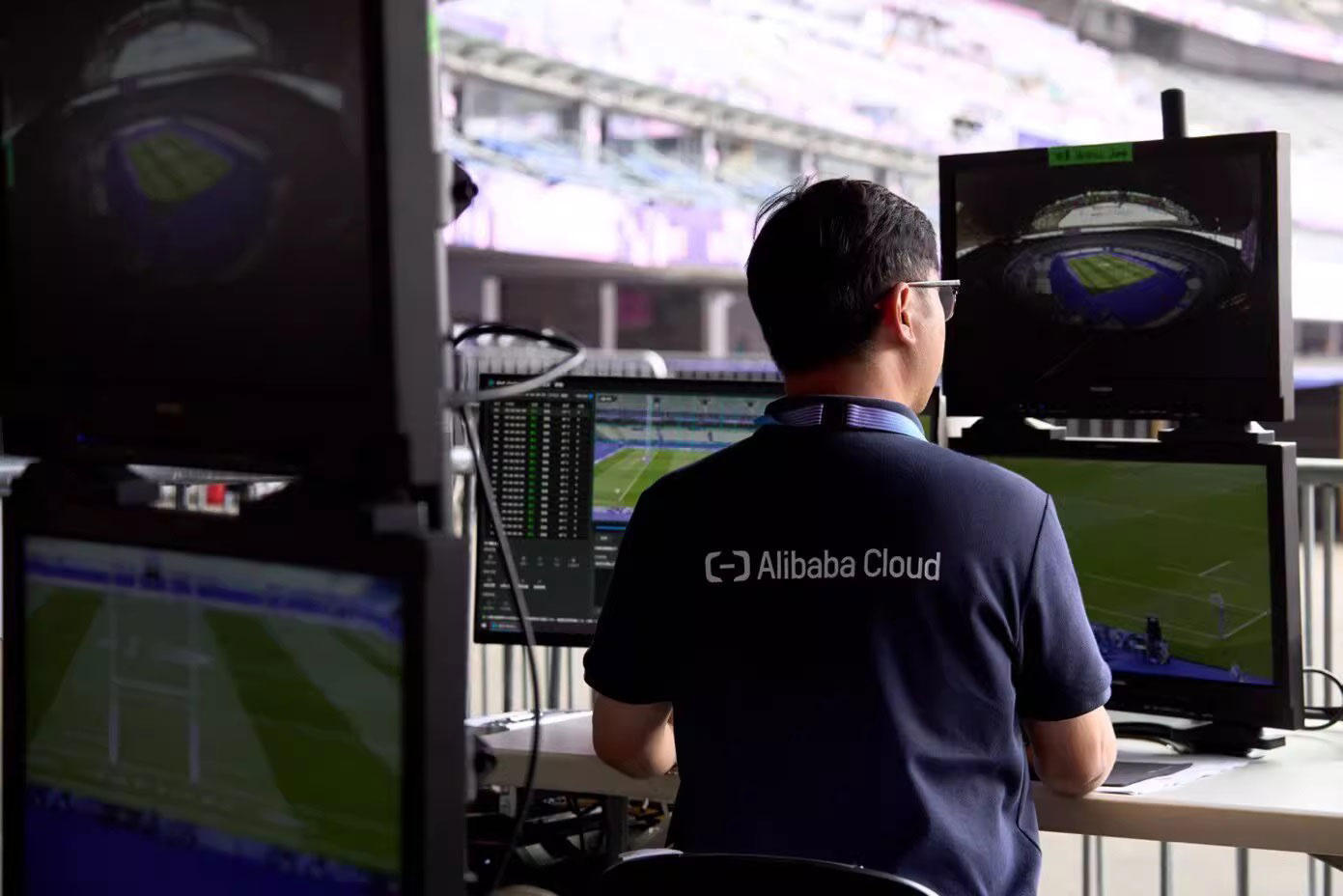Alibaba Cloud และ OBS เปิดตัว AI-Fueled OBS Cloud 3.0 ณ การแข่งขันโอลิมปิก กรุงปารีส
- การส่งสัญญาณสดผ่าน OBS Live Cloud กลายเป็นวิธีการหลักในการส่งสัญญาณระยะไกลไปยังผู้แพร่ภาพกระจายเสียงต่าง ๆ ซึ่งนับเป็นอีกหนึ่งความก้าวหน้าสำคัญของการถ่ายทอดการแข่งขันกีฬาโอลิมปิก
- แพลตฟอร์ม Content+ Portal ช่วยให้มั่นใจได้ว่าการส่งผ่านคอนเทนต์จะเป็นไปอย่างราบรื่น และระบบ Multi-Camera Replay ช่วยให้สามารถรีเพลย์ภาพแบบสโลว์โมชั่นโดยที่สามารถหยุดเฟรมที่ต้องการได้
อาลีบาบา คลาวด์ (Alibaba Cloud) ธุรกิจด้านเทคโนโลยีดิจิทัลและหน่วยงานหลักด้านอินเทลลิเจนซ์ของอาลีบาบา กรุ๊ป ร่วมกับ หน่วยบริการกระจายเสียงแพร่ภาพโอลิมปิก (Olympic Broadcasting Services: OBS) เปิดตัว OBS Cloud 3.0 เพื่อใช้ในการแข่งขันในโอลิมปิก ณ กรุงปารีส 2024 (Paris 2024) OBS Cloud 3.0 เป็นการผสานรวมเทคโนโลยีคลาวด์ที่มาพร้อมพลังของ AI ช่วยให้ OBS Cloud 3.0 สามารถทำงานร่วมกับผู้ได้รับลิขสิทธิ์ถ่ายทอดการแข่งขัน (Media Rights-Holders: MRHs) ได้สะดวกและมีประสิทธิภาพมากขึ้น ทั้งนี้ Paris 2024 ใช้ OBS Cloud 3.0 เป็นโครงสร้างพื้นฐานหลักเพื่อสนับสนุนการปฎิบัติงานสำคัญหลายส่วน ทั้งยังใช้ประโยชน์จากคุณสมบัติของคลาวด์ที่สามารถปรับขนาดการทำงานได้ (operational scalability) และคุ้มค่าการลงทุนได้อย่างเต็มประสิทธิภาพ รวมถึงช่วยให้ใช้พลังงานและทรัพยากรอย่างยั่งยืนมากขึ้น ด้วยความสามารถในการทำงานจากระยะไกล การทำงานร่วมกันแบบเรียลไทม์อย่างมีประสิทธิภาพ และอื่น ๆ อีกมาก
นับเป็นครั้งแรกในประวัติศาสตร์การแข่งขันโอลิมปิกที่มีการนำโซลูชัน OBS Live Cloud ซึ่งเป็นส่วนหนึ่งของ OBS Cloud 3.0 มาใช้เป็นวิธีการหลักสำหรับการแพร่ภาพกระจายเสียงการแข่งขันกีฬาโอลิมปิกไปยัง MRHs ทั้งนี้เป็นการเปลี่ยนจากการถ่ายทอดผ่านสัญญาณดาวเทียมที่ใช้ในการแข่งขัน Olympics Games Tokyo 1964
สำหรับปารีส 2024 นี้ สองในสามของผู้ให้บริการแพร่ภาพกระจายเสียงที่จองใช้บริการระยะไกลมาแล้ว (จากทั้งหมด 54 ราย) กำลังใช้ OBS Live Cloud ซึ่งในจำนวนนี้มีผู้แพร่ภาพกระจายเสียงความละเอียดระดับพิเศษ (Ultra High Definition: UHD) จำนวน 2 ราย ทั้งนี้ยังรวมถึงวิดีโอจำนวน 379 รายการ (เป็นความละเอียดระดับ UHD จำนวน 11 รายการ และความละเอียดระดับ HD จำนวน 368 รายการ) รวมถึงการส่งสัญญาณเสียง (audio feeds) 100 รายการ จะส่งผ่าน Live Cloud ด้วยข้อดีของการตอบสนองที่รวดเร็ว (low latency) และความยืดหยุ่นสูง (high resilence) ทำให้การส่งคอนเทนต์ผ่านคลาวด์ มีประสิทธิภาพเหนือกว่าวิธีการแพร่สัญญาณอื่น ๆ ในแง่ของการปรับขยายขนาดการทำงาน ความยืดหยุ่น และค่าใช้จ่ายในขณะเดียวกันก็เพิ่มความเสถียรและความคล่องตัวในการถ่ายทอดสดมหกรรมกีฬาขนาดใหญ่เช่นนี้
OBS Live Cloud เปิดตัวในการแข่งขัน Olympic Games Tokyo 2020 ให้กับผู้แพร่ภาพกระจายเสียงความละเอียดระดับ UHD หนึ่งราย และได้รับการเสนอเป็นบริการมาตรฐานเป็นครั้งแรกใน Olympic Winter Games Beijing 2022 โดยมีผู้แพร่ภาพกระจายเสียงสมัครเข้าใช้งานจำนวน 22 ราย ก่อนหน้าที่จะมีเทคโนโลยีล้ำหน้าเช่น OBS Live Cloud นี้ ผู้แพร่ภาพกระจายเสียงต้องพึ่งพาวงจรโทรคมนาคมออปติก ระหว่างประเทศที่ใช้งานด้านนี้โดยเฉพาะและมีค่าใช้จ่ายสูง รวมถึงต้องใช้เวลามากในการติดตั้งอุปกรณ์ เพื่อส่งภาพสัญญาณสดไปทั่วโลก จากสถานที่แข่งขันกลับไปยังประเทศของตน
Yiannis Exarchos, OBS Chief Executive Officer, กล่าว ณ ศูนย์แพร่สัญญาณนานาชาติของ Alibaba (Alibaba Cloud International Broadcasting Center: IBC) ระหว่างการเปิดตัว OBS Cloud 3.0 ว่า “เทคโนโลยีของ Alibaba Cloud ช่วยให้เราบอกเล่าเรื่องราวของนักกีฬาที่ประสบความสำเร็จมากที่สุดในโลก ให้กับประชากรประมาณครึ่งหนึ่งของโลกที่รับชมการแข่งขันนี้ได้ ทั้งยังนำผู้คนจากทั่วโลกให้มาร่วมกันสัมผัสประสบการณ์ที่น่าตื่นเต้นและสร้างแรงบันดาลใจได้มากขึ้น การถ่ายทอดการแข่งขัน คือ งานที่เป็นรากฐานสำคัญของความพยายามที่จะทำให้เกิดการสร้างสรรค์ดังกล่าว และการมีพันธมิตรเช่น Alibaba ช่วยให้เราสามารถทำความปรารถนานั้นให้เป็นจริงและมีคุณค่ากับเราอย่างมาก”
ทำลายสถิติด้วยการผลิตคอนเทนต์โอลิมปิกกว่า 11,000 ชั่วโมง ผ่านแพลตฟอร์ม Content+ บนคลาวด์
Content+ ซึ่งเป็นแพลตฟอร์มสำหรับส่งคอนเทนต์ของ OBS ยังคงโฮสต์อยู่บน Alibaba Cloudอย่างเต็มรูปแบบ เพื่อลดความซับซ้อนให้กับเวิร์กโฟลว์ด้านโปรดักชั่นจากระยะไกลอย่างต่อเนื่อง และให้มั่นใจว่าการส่งคอนเทนต์จะเป็นไปอย่างราบรื่นไม่สะดุด ไม่ว่าจะเป็นการไลฟ์สด การสัมภาษณ์นักกีฬา ฟุตเทจเบื้องหลังสถานการณ์ต่าง ๆ และโซเชียลมีเดียคอนเทนต์
ณ การแข่งขัน Paris 2024, OBS จะผลิตคอนเทนต์มากกว่า 11,000 ชั่วโมง ซึ่งเพิ่มขึ้น 15% จากการแข่งขัน Tokyo 2020 วิธีการที่ทรงประสิทธิภาพของพอร์ทัลบนคลาวด์นี้ ช่วยให้การทำโปรดักชั่นจากระยะไกลง่ายขึ้น และมั่นใจได้ว่าการส่งคอนเทนต์จะเป็นไปอย่างราบรื่นไม่หยุดชะงักระหว่างการแข่งขัน
ฟังก์ชันใหม่ ๆ ของแพลตฟอร์ม Content+ ช่วยให้ MRHs สร้างไฮไลท์ของคอนเทนต์ต่าง ๆ ตามต้องการจากที่ใดในโลกก็ได้ โดยใช้เวลาทำงานให้เสร็จสั้นลงมาก ทั้งยังสามารถดาวน์โหลดคอนเทนต์ได้ด้วยความละเอียดที่แตกต่างกันถึงสามระดับเพื่อให้เหมาะกับการใช้งาน คือ ลิเนียร์, ดิจิทัล และ/หรือโซเชียล
Content+ จะส่งคอนเทนต์การแข่งขันมากมายที่ผลิตโดย OBS ให้ MRHs ทั่วโลกในรูปแบบ UHD เป็นครั้งแรก ผ่านโครงสร้างพื้นฐานที่แข็งแกร่งระดับโลกของ Alibaba Cloud ซึ่งช่วยให้ผู้ออกอากาศสามารถผลิตคอนเทนต์ที่ดึงดูดให้ผู้คนเข้ามามีส่วนร่วม และมีความประณีตละเอียดลออมากขึ้น ด้วยการใช้ฟีเจอร์ใหม่ ๆ เช่น การปรับหน้าจอเป็นแนวตั้งเพื่อให้เหมาะกับการรับชมผ่านโทรศัพท์มือถือ หรือ อุปกรณ์อื่น ๆ
เซลิน่า หยวน ประธานด้านธุรกิจระหว่างประเทศ อาลีบาบา คลาวด์ อินเทลลิเจนซ์ กล่าวว่า “เรารู้สึกตื่นเต้นอย่างมากที่ได้เห็นวิวัฒนาการของการถ่ายทอดการแข่งขันกีฬาโอลิมปิกตั้งแต่ Tokyo 2020 จนถึง Paris 2024 ผ่านโครงสร้างพื้นฐานที่แข็งแกร่งของ Alibaba Cloud และเทคโนโลยี AI ที่ได้รับการพิสูจน์ประสิทธิภาพแล้ว ความร่วมมือระหว่าง Alibaba Cloud และ OBS ขยายความมุ่งมั่นของเราที่จะช่วยเปลี่ยนผ่านประสบการณ์ของผู้ชมการแข่งขันโอลิมปิก ให้พลิกโฉมจากนวัตกรรมทางเทคโนโลยี ไปสู่ การปฏิบัติจริงเพื่อผลลัพธ์ที่จับต้องได้ เรารู้สึกเป็นเกียรติที่ได้สนับสนุน Paris 2024 ให้เป็นการแข่งขันกีฬาโอลิมปิกที่ดึงดูดความสนใจทางดิจิทัลมากที่สุดเท่าที่เคยมีมา”
ยกระดับประสบการณ์ผู้ชม ด้วยระบบ Replay ที่ใช้เทคโนโลยี AI ที่ล้ำสมัย
ระหว่างการแข่งขันโอลิมปิก Paris 2024 ระบบ OBS Multi-Camera Replay จะทำให้ผู้ชมสามารถชมภาพสโลว์โมชั่นรีเพลย์ (เล่นซ้ำ) ของนักกีฬาขณะทำการแข่งขันแบบที่สามารถหยุดเฟรมได้ ช่วยให้แฟนกีฬาตัวยงได้เห็นภาพการแข่งขันโดยละเอียด และวิเคราะห์การเคลื่อนไหวต่าง ๆของนักกีฬาได้อย่างลึกซึ้ง สำหรับผู้ชมกีฬาหน้าใหม่ อาจใช้การรีเพลย์เหล่านี้เป็นเครื่องมือเพื่อเรียนรู้ให้เข้าใจช่วงเวลาสำคัญของการแข่งขันได้มากขึ้น
Alibaba Cloud เป็นผู้ให้บริการระบบ multi-camera replay ณ การแข่งขันโอลิมปิก Paris 2024 ประกอบด้วย 17 ระบบ ใช้กับสถานที่ 14 แห่ง ครอบคลุม 21 ชนิดกีฬาและรายการที่เกี่ยวข้อง เช่นรักบี้เจ็ดคน แบดมินตัน กรีฑาลู่และลาน บาสเกตบอล วอลเลย์บอลชายหาด ปิงปอง มวยปล้ำ เทนนิส ยูโด เบรกกิ้ง บีเอ็มเอ็กซ์ฟรีสไตล์ และสเกตบอร์ด โดยฟุตเทจจะถูกส่งไปยังระบบคลาวด์ที่มีศักยภาพในการประมวลผลที่ขับเคลื่อนด้วย AI ของ Alibaba Cloud ซึ่งสามารถดึงฟุตเทจที่เลือกมาทำใหม่ และการเรนเดอร์ 3 มิติแบบเรียลไทม์ ก่อนที่ช่วงเวลาเคลื่อนไหวของนักกีฬาที่เลือกไว้จะถูกแชร์เป็นแบบรีเพลย์ผ่านฟีดสดหรือฟีดภายหลัง การสร้างช่วงเวลาที่ตื่นเต้นที่สุดขึ้นมาใหม่อย่างราบรื่นนี้ ใช้เวลาเพียงไม่กี่วินาทีในการเตรียมพร้อมบนคลาวด์ และช่วงเวลารีเพลย์นี้จะรวมเป็นส่วนหนึ่งกับการถ่ายทอดสด
นอกจากนี้ OBS Olympic Video Player (OVP) ซึ่งเป็นบริการ multi-platform video player ที่ล้ำสมัย จะใช้โครงสร้างพื้นฐานของ Alibaba Cloud รองรับการสตรีมสดแบบ UHD เป็นครั้งแรก บริการ OVP ช่วย MRHs ทั้งหลาย โดยเฉพาะ MRHs ที่มีขนาดเล็กและขนาดกลาง ได้ใช้โซลูชันครบวงจรเพื่อส่งวิดีโอคุณภาพสูงให้แก่ผู้ชมของตน โดยไม่ต้องทำการพัฒนาที่ซับซ้อนด้วยตนเอง
จากการเป็นพันธมิตรระดับโลกของโอลิมปิกเมื่อเดือนมกราคม 2017 ในปี 2018 Alibaba Cloud และ OBS ได้เปิดตัว OBS Cloud หลังจากนั้นได้ให้การสนับสนุนการแข่งขันโอลิมปิก Tokyo 2020 ซึ่งเป็นครั้งแรกที่มีการถ่ายทอดสัญญาณการแข่งขันโอลิมปิกผ่านคลาวด์ นับแต่นั้นเป็นต้นมา Alibaba Cloud ได้ทำงานร่วมกับ OBS เพื่อคงมาตรฐานการเผยแพร่ภาพและกระจายเสียงการแข่งขันโอลิมปิกให้อยู่ในระดับสูงสุด ด้วยเทคโนโลยีคลาวด์ที่ได้รับการพิสูจน์ประสิทธิภาพแล้ว
สามารถรับชม b-roll ของ Alibaba Cloud IBC Showcase ณ โอลิมปิก Paris 2024 ได้ที่ลิงก์นี้: https://www.alizila.com/media-resource/b-roll-alibaba-cloud-international-broadcasting-centre-showcase-paris-2024/






